Factors affecting the capacity of accounting software in controlling frauds and errors in small and medium enterprises (smes): A case study of smes in Ha Noi, Viet Nam
Financial accounting information has impacted the operation of
enterprises, especially SMEs. With the development of technology,
digital accounting applications are playing an increasingly important
role in minimizing mistakes, and ensuring the accuracy and
timeliness of accounting information. Using multiple discriminant
analyses, this study confirmed the significance of accounting
software in reducing frauds and errors in SMEs’ businesses despite
some drawbacks. It showed that the managers’ ability to access the
software and the decentralization of power in accessing the
accounting software were the two key factors deciding the
success/failure of applying accounting software to control frauds and
errors. In addition, smart applications of the accounting software
positively contributed to the elimination of frauds in enterprises.
Based on these results, recommendations are drawn for SMEs, such
as investing more in smart applications of accounting software, as
well as updating knowledge about accounting for management, in
order to get more advantages from accounting software applications
for their business in the long term.
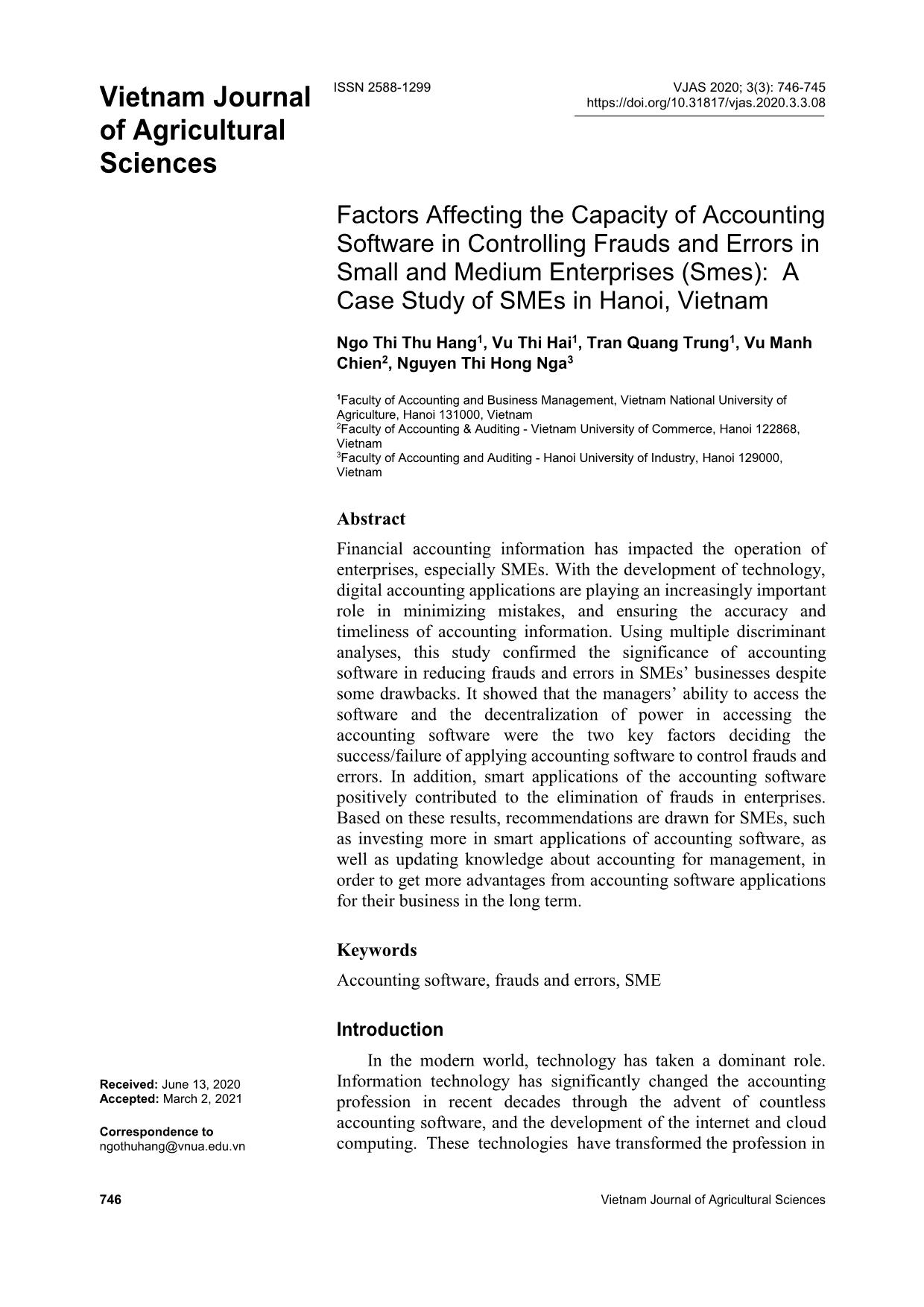
Trang 1
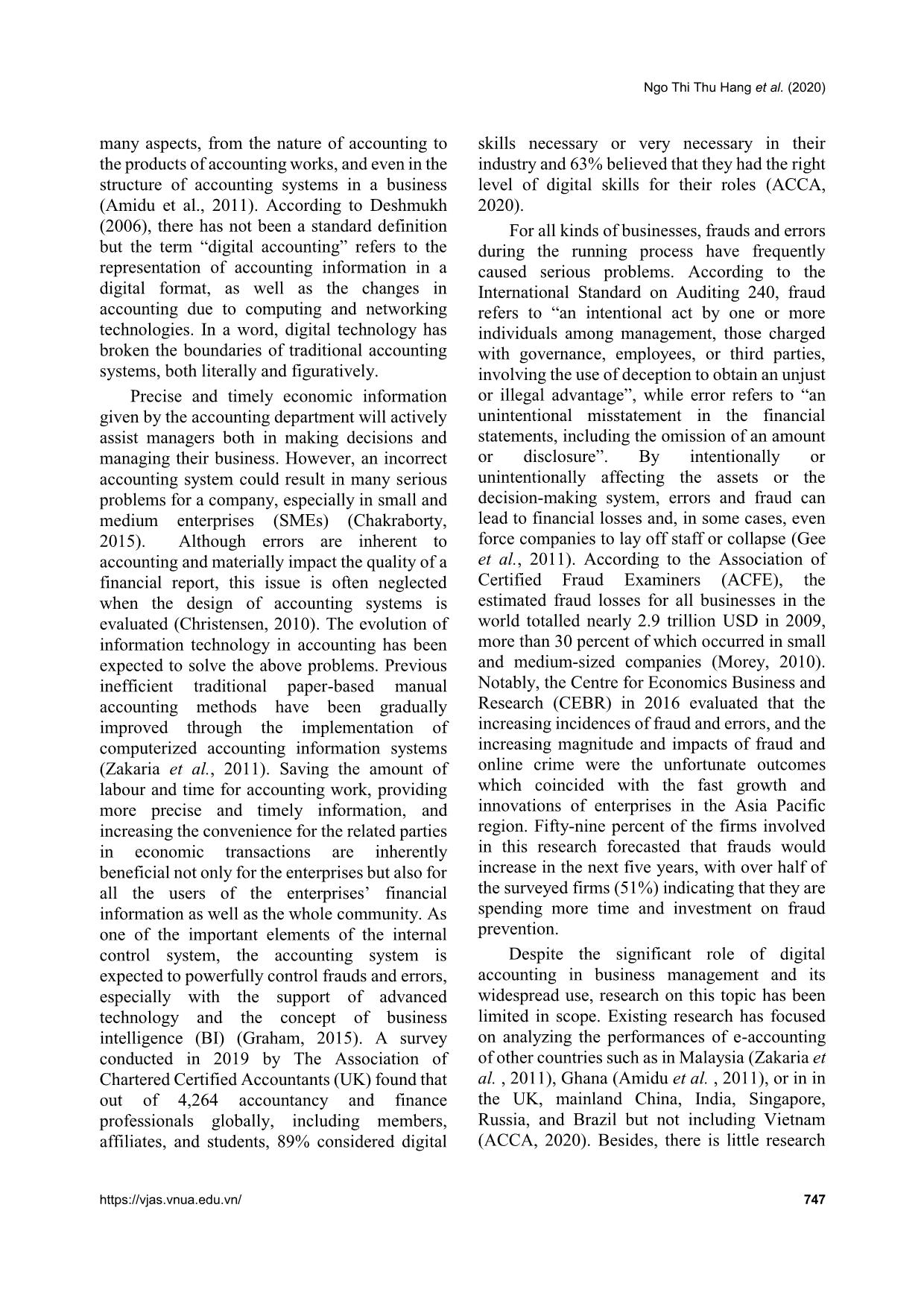
Trang 2

Trang 3
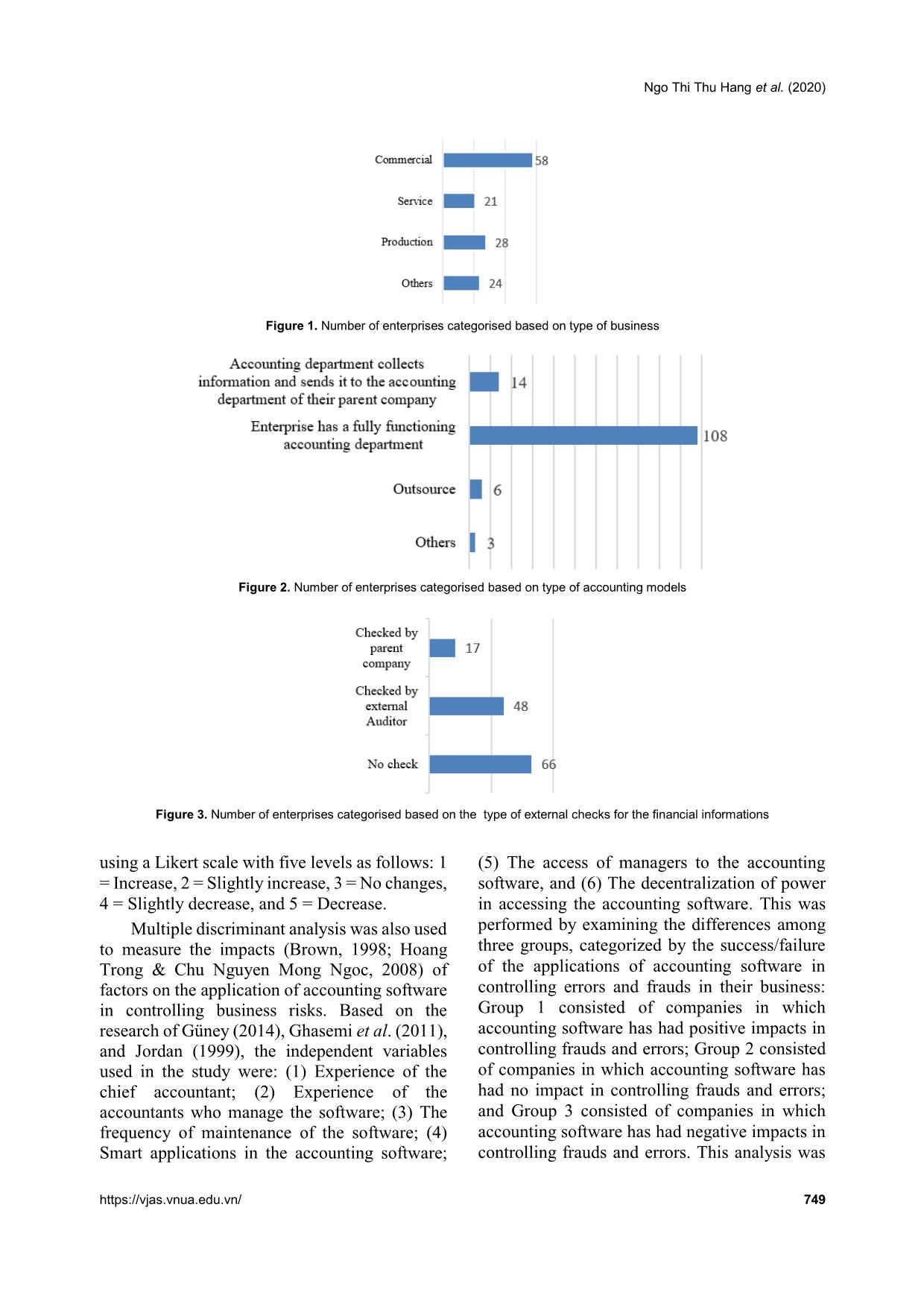
Trang 4
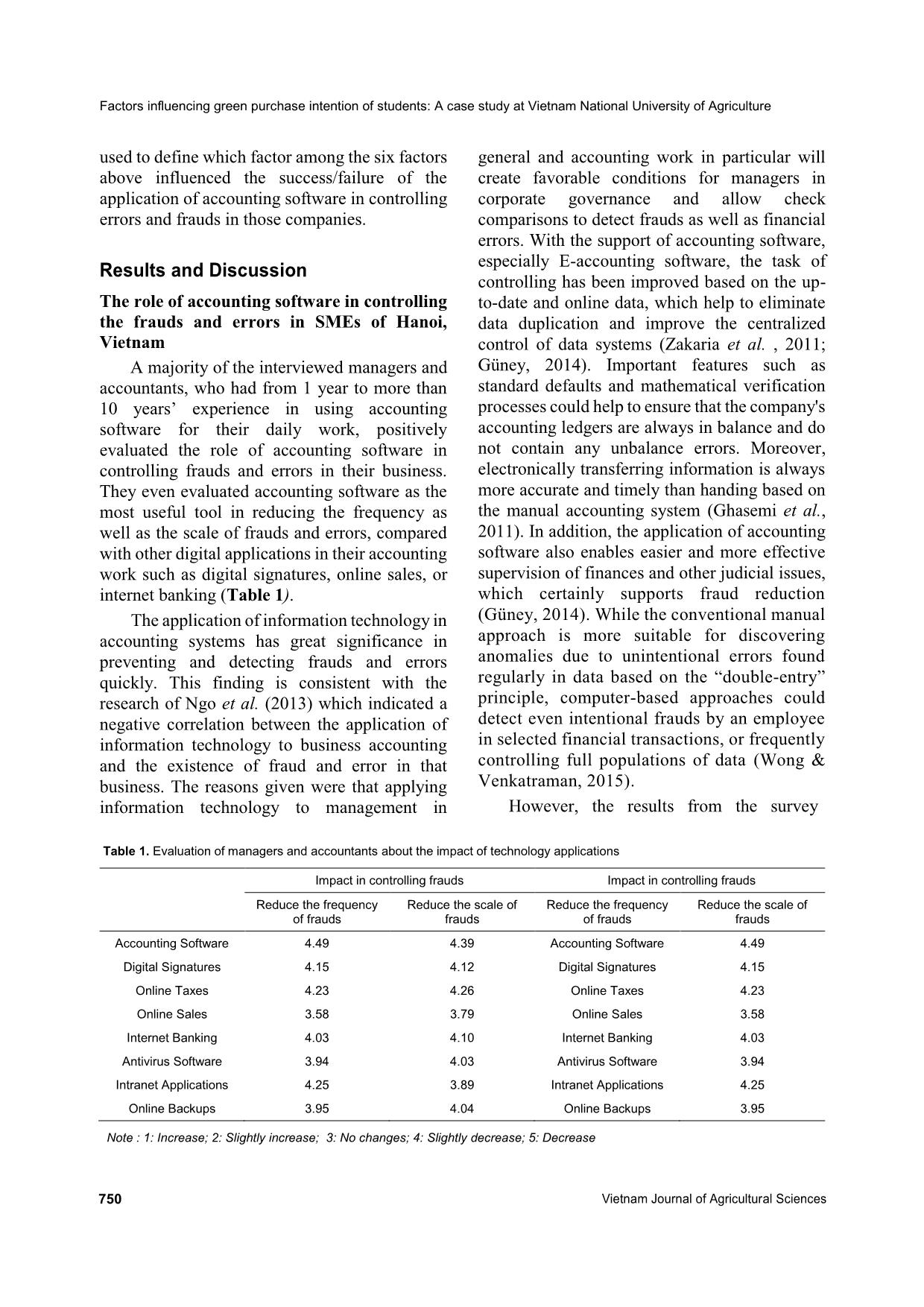
Trang 5
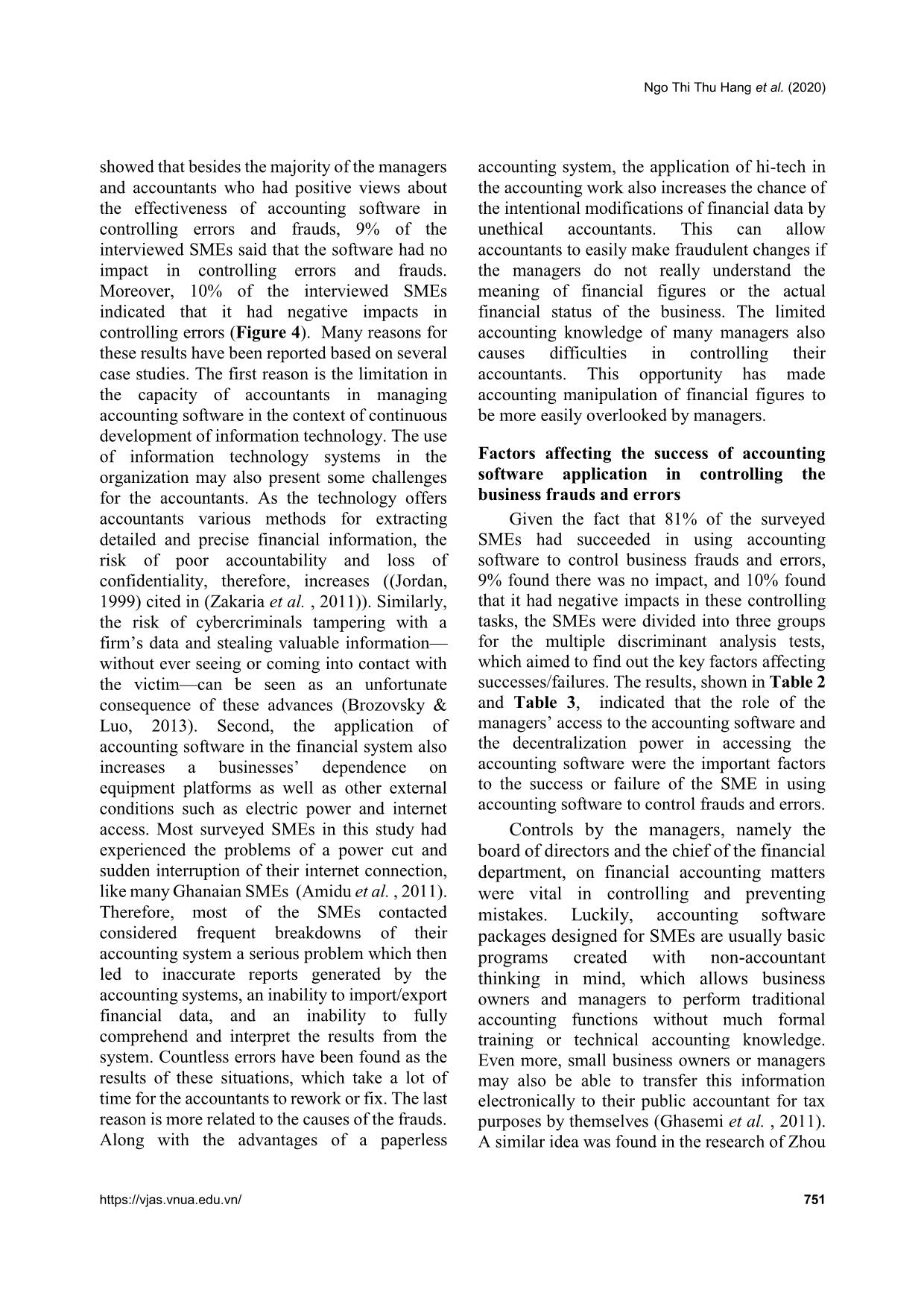
Trang 6
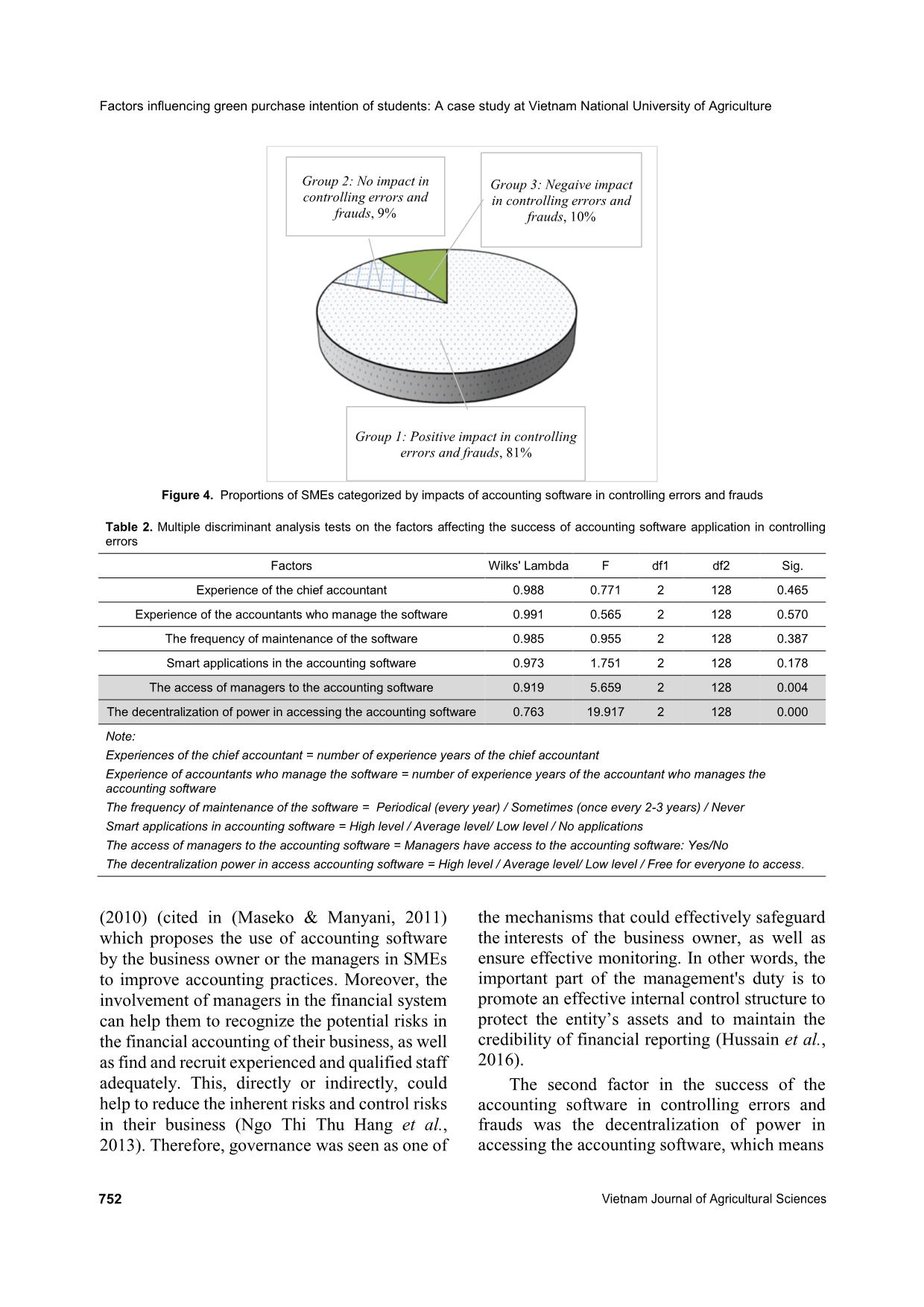
Trang 7
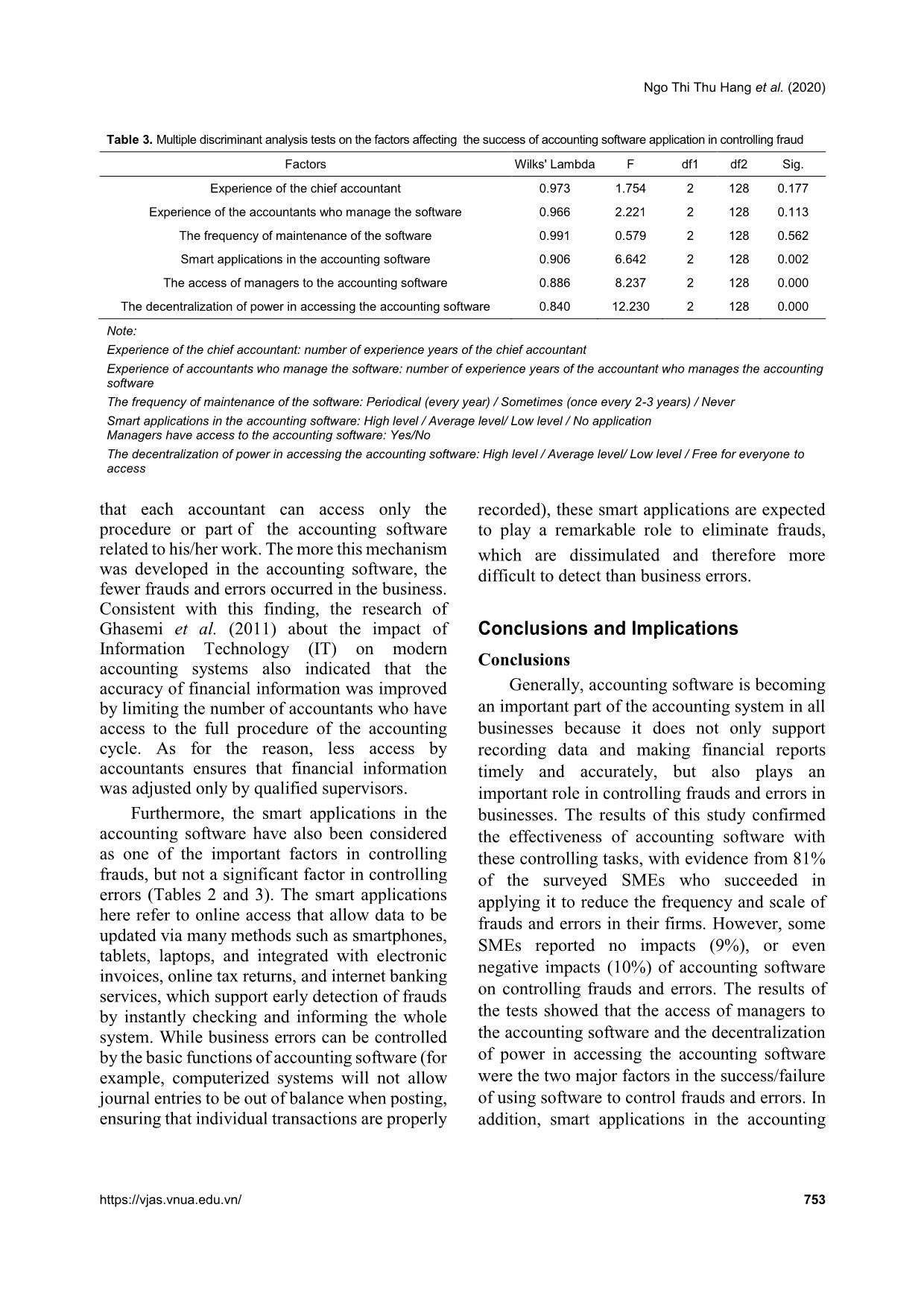
Trang 8
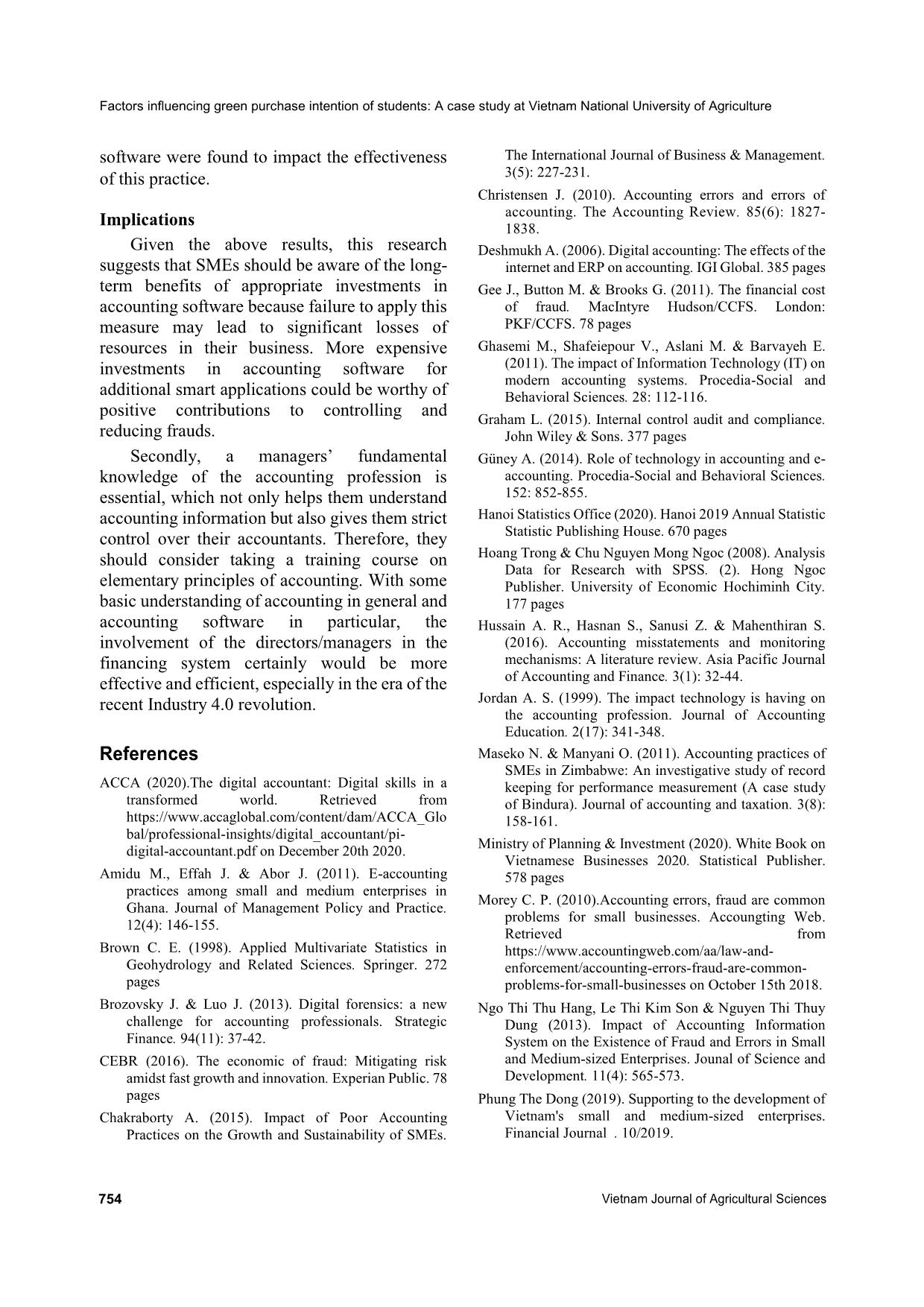
Trang 9
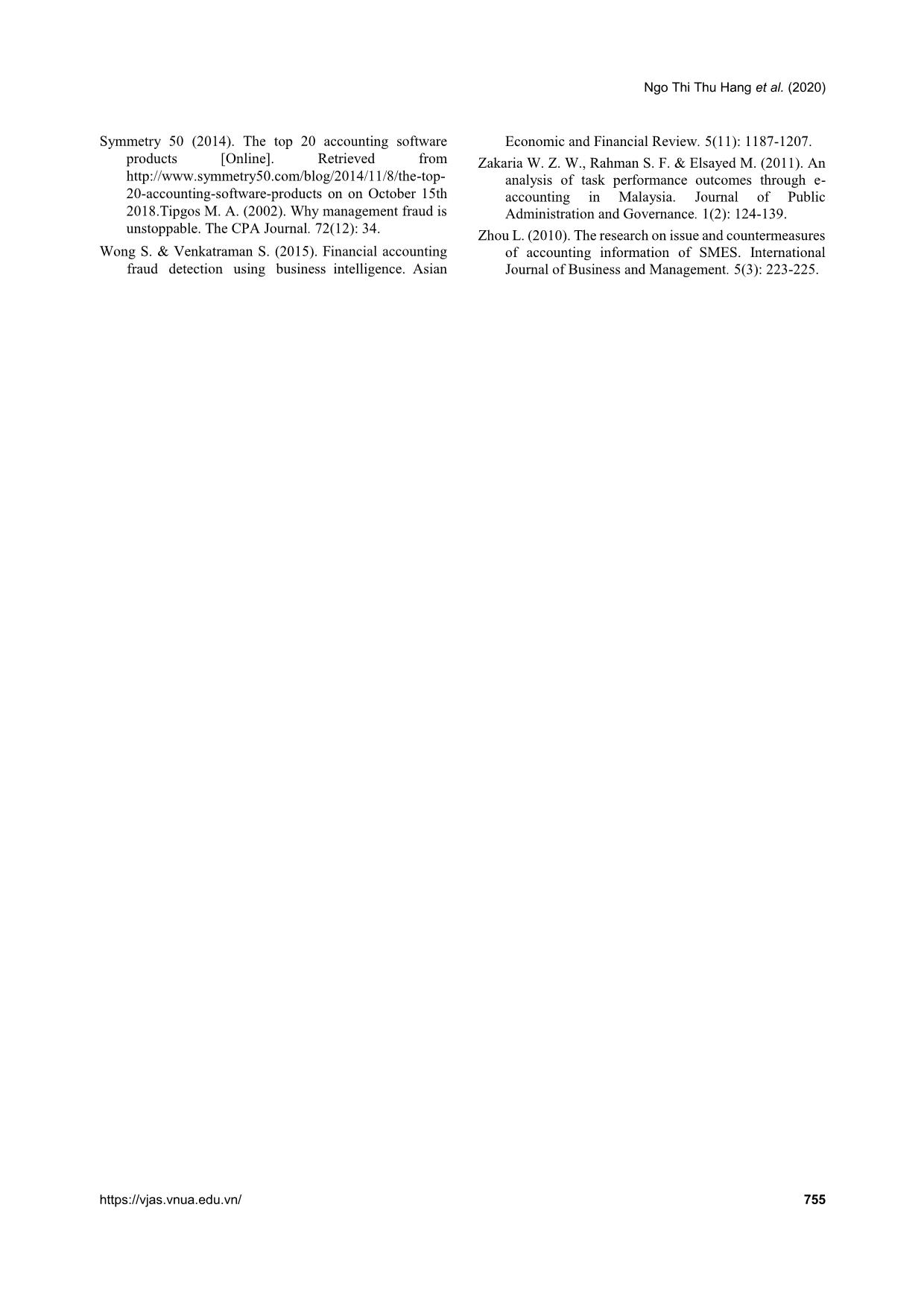
Trang 10
Tóm tắt nội dung tài liệu: Factors affecting the capacity of accounting software in controlling frauds and errors in small and medium enterprises (smes): A case study of smes in Ha Noi, Viet Nam
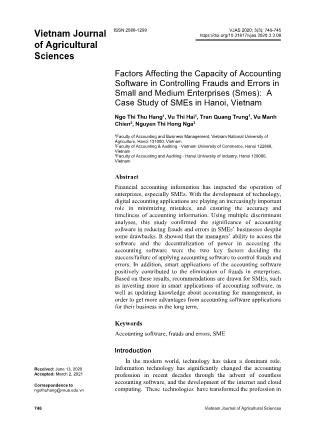
Vietnam Journal of Agricultural Sciences ISSN 2588-1299 VJAS 2020; 3(3): 746-745 https://doi.org/10.31817/vjas.2020.3.3.08 746 Vietnam Journal of Agricultural Sciences Received: June 13, 2020 Accepted: March 2, 2021 Correspondence to ngothuhang@vnua.edu.vn Factors Affecting the Capacity of Accounting Software in Controlling Frauds and Errors in Small and Medium Enterprises (Smes): A Case Study of SMEs in Hanoi, Vietnam Ngo Thi Thu Hang1, Vu Thi Hai1, Tran Quang Trung1, Vu Manh Chien2, Nguyen Thi Hong Nga3 1Faculty of Accounting and Business Management, Vietnam National University of Agriculture, Hanoi 131000, Vietnam 2Faculty of Accounting & Auditing - Vietnam University of Commerce, Hanoi 122868, Vietnam 3Faculty of Accounting and Auditing - Hanoi University of Industry, Hanoi 129000, Vietnam Abstract Financial accounting information has impacted the operation of enterprises, especially SMEs. With the development of technology, digital accounting applications are playing an increasingly important role in minimizing mistakes, and ensuring the accuracy and timeliness of accounting information. Using multiple discriminant analyses, this study confirmed the significance of accounting software in reducing frauds and errors in SMEs’ businesses despite some drawbacks. It showed that the managers’ ability to access the software and the decentralization of power in accessing the accounting software were the two key factors deciding the success/failure of applying accounting software to control frauds and errors. In addition, smart applications of the accounting software positively contributed to the elimination of frauds in enterprises. Based on these results, recommendations are drawn for SMEs, such as investing more in smart applications of accounting software, as well as updating knowledge about accounting for management, in order to get more advantages from accounting software applications for their business in the long term. Keywords Accounting software, frauds and errors, SME Introduction In the modern world, technology has taken a dominant role. Information technology has significantly changed the accounting profession in recent decades through the advent of countless accounting software, and the development of the internet and cloud computing. These technologies have transformed the profession in Ngo Thi Thu Hang et al. (2020) https://vjas.vnua.edu.vn/ 747 many aspects, from the nature of accounting to the products of accounting works, and even in the structure of accounting systems in a business (Amidu et al., 2011). According to Deshmukh (2006), there has not been a standard definition but the term “digital accounting” refers to the representation of accounting information in a digital format, as well as the changes in accounting due to computing and networking technologies. In a word, digital technology has broken the boundaries of traditional accounting systems, both literally and figuratively. Precise and timely economic information given by the accounting department will actively assist managers both in making decisions and managing their business. However, an incorrect accounting system could result in many serious problems for a company, especially in small and medium enterprises (SMEs) (Chakraborty, 2015). Although errors are inherent to accounting and materially impact the quality of a financial report, this issue is often neglected when the design of accounting systems is evaluated (Christensen, 2010). The evolution of information technology in accounting has been expected to solve the above problems. Previous inefficient traditional paper-based manual accounting methods have been gradually improved through the implementation of computerized accounting information systems (Zakaria et al., 2011). Saving the amount of labour and time for accounting work, providing more precise and timely information, and increasing the convenience for the related parties in economic transactions are inherently beneficial not only for the enterprises but also for all the users of the enterprises’ financial information as well as the whole community. As one of the important elements of the internal control system, the accounting system is expected to powerfully control frauds and errors, especially with the support of advanced technology and the concept of business intelligence (BI) (Graham, 2015). A survey conducted in 2019 by The Association of Chartered Certified Accountants (UK) found that out of 4,264 accountancy and finance professionals globally, including members, affiliates, and students, 89% considered digital skills necessary or very necessary in their industry and 63% believed that they had the right level of digital skills for their roles (ACCA, 2020). For all kinds of businesses, frauds and errors ... to fully comprehend and interpret the results from the system. Countless errors have been found as the results of these situations, which take a lot of time for the accountants to rework or fix. The last reason is more related to the causes of the frauds. Along with the advantages of a paperless accounting system, the application of hi-tech in the accounting work also increases the chance of the intentional modifications of financial data by unethical accountants. This can allow accountants to easily make fraudulent changes if the managers do not really understand the meaning of financial figures or the actual financial status of the business. The limited accounting knowledge of many managers also causes difficulties in controlling their accountants. This opportunity has made accounting manipulation of financial figures to be more easily overlooked by managers. Factors affecting the success of accounting software application in controlling the business frauds and errors Given the fact that 81% of the surveyed SMEs had succeeded in using accounting software to control business frauds and errors, 9% found there was no impact, and 10% found that it had negative impacts in these controlling tasks, the SMEs were divided into three groups for the multiple discriminant analysis tests, which aimed to find out the key factors affecting successes/failures. The results, shown in Table 2 and Table 3, indicated that the role of the managers’ access to the accounting software and the decentralization power in accessing the accounting software were the important factors to the success or failure of the SME in using accounting software to control frauds and errors. Controls by the managers, namely the board of directors and the chief of the financial department, on financial accounting matters were vital in controlling and preventing mistakes. Luckily, accounting software packages designed for SMEs are usually basic programs created with non-accountant thinking in mind, which allows business owners and managers to perform traditional accounting functions without much formal training or technical accounting knowledge. Even more, small business owners or managers may also be able to transfer this information electronically to their public accountant for tax purposes by themselves (Ghasemi et al. , 2011). A similar idea was found in the research of Zhou Factors influencing green purchase intention of students: A case study at Vietnam National University of Agriculture 752 Vietnam Journal of Agricultural Sciences Figure 4. Proportions of SMEs categorized by impacts of accounting software in controlling errors and frauds (2010) (cited in (Maseko & Manyani, 2011) which proposes the use of accounting software by the business owner or the managers in SMEs to improve accounting practices. Moreover, the involvement of managers in the financial system can help them to recognize the potential risks in the financial accounting of their business, as well as find and recruit experienced and qualified staff adequately. This, directly or indirectly, could help to reduce the inherent risks and control risks in their business (Ngo Thi Thu Hang et al., 2013). Therefore, governance was seen as one of the mechanisms that could effectively safeguard the interests of the business owner, as well as ensure effective monitoring. In other words, the important part of the management's duty is to promote an effective internal control structure to protect the entity’s assets and to maintain the credibility of financial reporting (Hussain et al., 2016). The second factor in the success of the accounting software in controlling errors and frauds was the decentralization of power in accessing the accounting software, which means Group 1: Positive impact in controlling errors and frauds, 81% Group 2: No impact in controlling errors and frauds, 9% Group 3: Negaive impact in controlling errors and frauds, 10% Table 2. Multiple discriminant analysis tests on the factors affecting the success of accounting software application in controlling errors Factors Wilks' Lambda F df1 df2 Sig. Experience of the chief accountant 0.988 0.771 2 128 0.465 Experience of the accountants who manage the software 0.991 0.565 2 128 0.570 The frequency of maintenance of the software 0.985 0.955 2 128 0.387 Smart applications in the accounting software 0.973 1.751 2 128 0.178 The access of managers to the accounting software 0.919 5.659 2 128 0.004 The decentralization of power in accessing the accounting software 0.763 19.917 2 128 0.000 Note: Experiences of the chief accountant = number of experience years of the chief accountant Experience of accountants who manage the software = number of experience years of the accountant who manages the accounting software The frequency of maintenance of the software = Periodical (every year) / Sometimes (once every 2-3 years) / Never Smart applications in accounting software = High level / Average level/ Low level / No applications The access of managers to the accounting software = Managers have access to the accounting software: Yes/No The decentralization power in access accounting software = High level / Average level/ Low level / Free for everyone to access. Ngo Thi Thu Hang et al. (2020) https://vjas.vnua.edu.vn/ 753 Table 3. Multiple discriminant analysis tests on the factors affecting the success of accounting software application in controlling fraud Factors Wilks' Lambda F df1 df2 Sig. Experience of the chief accountant 0.973 1.754 2 128 0.177 Experience of the accountants who manage the software 0.966 2.221 2 128 0.113 The frequency of maintenance of the software 0.991 0.579 2 128 0.562 Smart applications in the accounting software 0.906 6.642 2 128 0.002 The access of managers to the accounting software 0.886 8.237 2 128 0.000 The decentralization of power in accessing the accounting software 0.840 12.230 2 128 0.000 Note: Experience of the chief accountant: number of experience years of the chief accountant Experience of accountants who manage the software: number of experience years of the accountant who manages the accounting software The frequency of maintenance of the software: Periodical (every year) / Sometimes (once every 2-3 years) / Never Smart applications in the accounting software: High level / Average level/ Low level / No application Managers have access to the accounting software: Yes/No The decentralization of power in accessing the accounting software: High level / Average level/ Low level / Free for everyone to access that each accountant can access only the procedure or part of the accounting software related to his/her work. The more this mechanism was developed in the accounting software, the fewer frauds and errors occurred in the business. Consistent with this finding, the research of Ghasemi et al. (2011) about the impact of Information Technology (IT) on modern accounting systems also indicated that the accuracy of financial information was improved by limiting the number of accountants who have access to the full procedure of the accounting cycle. As for the reason, less access by accountants ensures that financial information was adjusted only by qualified supervisors. Furthermore, the smart applications in the accounting software have also been considered as one of the important factors in controlling frauds, but not a significant factor in controlling errors (Tables 2 and 3). The smart applications here refer to online access that allow data to be updated via many methods such as smartphones, tablets, laptops, and integrated with electronic invoices, online tax returns, and internet banking services, which support early detection of frauds by instantly checking and informing the whole system. While business errors can be controlled by the basic functions of accounting software (for example, computerized systems will not allow journal entries to be out of balance when posting, ensuring that individual transactions are properly recorded), these smart applications are expected to play a remarkable role to eliminate frauds, which are dissimulated and therefore more difficult to detect than business errors. Conclusions and Implications Conclusions Generally, accounting software is becoming an important part of the accounting system in all businesses because it does not only support recording data and making financial reports timely and accurately, but also plays an important role in controlling frauds and errors in businesses. The results of this study confirmed the effectiveness of accounting software with these controlling tasks, with evidence from 81% of the surveyed SMEs who succeeded in applying it to reduce the frequency and scale of frauds and errors in their firms. However, some SMEs reported no impacts (9%), or even negative impacts (10%) of accounting software on controlling frauds and errors. The results of the tests showed that the access of managers to the accounting software and the decentralization of power in accessing the accounting software were the two major factors in the success/failure of using software to control frauds and errors. In addition, smart applications in the accounting Factors influencing green purchase intention of students: A case study at Vietnam National University of Agriculture 754 Vietnam Journal of Agricultural Sciences software were found to impact the effectiveness of this practice. Implications Given the above results, this research suggests that SMEs should be aware of the long- term benefits of appropriate investments in accounting software because failure to apply this measure may lead to significant losses of resources in their business. More expensive investments in accounting software for additional smart applications could be worthy of positive contributions to controlling and reducing frauds. Secondly, a managers’ fundamental knowledge of the accounting profession is essential, which not only helps them understand accounting information but also gives them strict control over their accountants. Therefore, they should consider taking a training course on elementary principles of accounting. With some basic understanding of accounting in general and accounting software in particular, the involvement of the directors/managers in the financing system certainly would be more effective and efficient, especially in the era of the recent Industry 4.0 revolution. References ACCA (2020).The digital accountant: Digital skills in a transformed world. Retrieved from https://www.accaglobal.com/content/dam/ACCA_Glo bal/professional-insights/digital_accountant/pi- digital-accountant.pdf on December 20th 2020. Amidu M., Effah J. & Abor J. (2011). E-accounting practices among small and medium enterprises in Ghana. Journal of Management Policy and Practice. 12(4): 146-155. Brown C. E. (1998). Applied Multivariate Statistics in Geohydrology and Related Sciences. Springer. 272 pages Brozovsky J. & Luo J. (2013). Digital forensics: a new challenge for accounting professionals. Strategic Finance. 94(11): 37-42. CEBR (2016). The economic of fraud: Mitigating risk amidst fast growth and innovation. Experian Public. 78 pages Chakraborty A. (2015). Impact of Poor Accounting Practices on the Growth and Sustainability of SMEs. The International Journal of Business & Management. 3(5): 227-231. Christensen J. (2010). Accounting errors and errors of accounting. The Accounting Review. 85(6): 1827- 1838. Deshmukh A. (2006). Digital accounting: The effects of the internet and ERP on accounting. IGI Global. 385 pages Gee J., Button M. & Brooks G. (2011). The financial cost of fraud. MacIntyre Hudson/CCFS. London: PKF/CCFS. 78 pages Ghasemi M., Shafeiepour V., Aslani M. & Barvayeh E. (2011). The impact of Information Technology (IT) on modern accounting systems. Procedia-Social and Behavioral Sciences. 28: 112-116. Graham L. (2015). Internal control audit and compliance. John Wiley & Sons. 377 pages Güney A. (2014). Role of technology in accounting and e- accounting. Procedia-Social and Behavioral Sciences. 152: 852-855. Hanoi Statistics Office (2020). Hanoi 2019 Annual Statistic Statistic Publishing House. 670 pages Hoang Trong & Chu Nguyen Mong Ngoc (2008). Analysis Data for Research with SPSS. (2). Hong Ngoc Publisher. University of Economic Hochiminh City. 177 pages Hussain A. R., Hasnan S., Sanusi Z. & Mahenthiran S. (2016). Accounting misstatements and monitoring mechanisms: A literature review. Asia Pacific Journal of Accounting and Finance. 3(1): 32-44. Jordan A. S. (1999). The impact technology is having on the accounting profession. Journal of Accounting Education. 2(17): 341-348. Maseko N. & Manyani O. (2011). Accounting practices of SMEs in Zimbabwe: An investigative study of record keeping for performance measurement (A case study of Bindura). Journal of accounting and taxation. 3(8): 158-161. Ministry of Planning & Investment (2020). White Book on Vietnamese Businesses 2020. Statistical Publisher. 578 pages Morey C. P. (2010).Accounting errors, fraud are common problems for small businesses. Accoungting Web. Retrieved from https://www.accountingweb.com/aa/law-and- enforcement/accounting-errors-fraud-are-common- problems-for-small-businesses on October 15th 2018. Ngo Thi Thu Hang, Le Thi Kim Son & Nguyen Thi Thuy Dung (2013). Impact of Accounting Information System on the Existence of Fraud and Errors in Small and Medium-sized Enterprises. Jounal of Science and Development. 11(4): 565-573. Phung The Dong (2019). Supporting to the development of Vietnam's small and medium-sized enterprises. Financial Journal . 10/2019. Ngo Thi Thu Hang et al. (2020) https://vjas.vnua.edu.vn/ 755 Symmetry 50 (2014). The top 20 accounting software products [Online]. Retrieved from 20-accounting-software-products on on October 15th 2018.Tipgos M. A. (2002). Why management fraud is unstoppable. The CPA Journal. 72(12): 34. Wong S. & Venkatraman S. (2015). Financial accounting fraud detection using business intelligence. Asian Economic and Financial Review. 5(11): 1187-1207. Zakaria W. Z. W., Rahman S. F. & Elsayed M. (2011). An analysis of task performance outcomes through e- accounting in Malaysia. Journal of Public Administration and Governance. 1(2): 124-139. Zhou L. (2010). The research on issue and countermeasures of accounting information of SMES. International Journal of Business and Management. 5(3): 223-225.
File đính kèm:
 factors_affecting_the_capacity_of_accounting_software_in_con.pdf
factors_affecting_the_capacity_of_accounting_software_in_con.pdf

